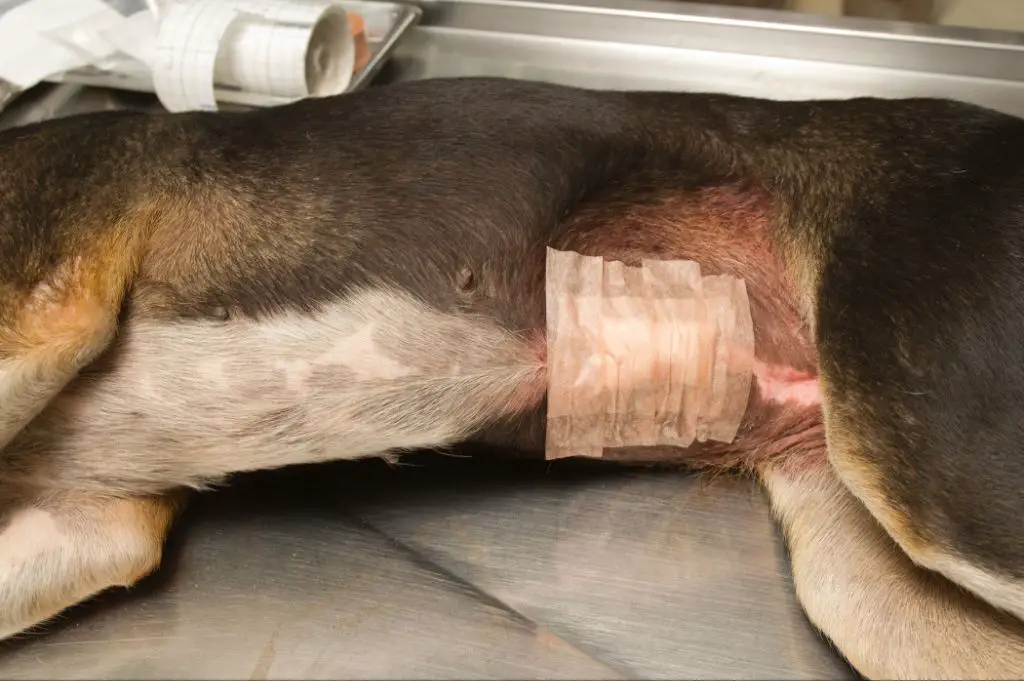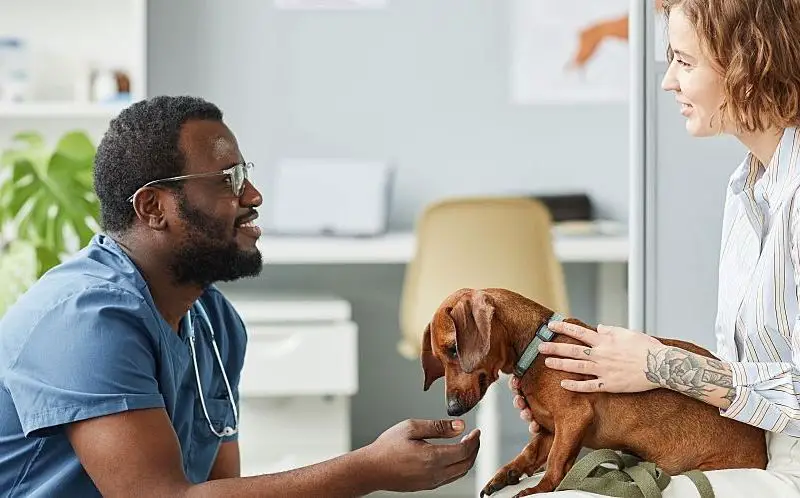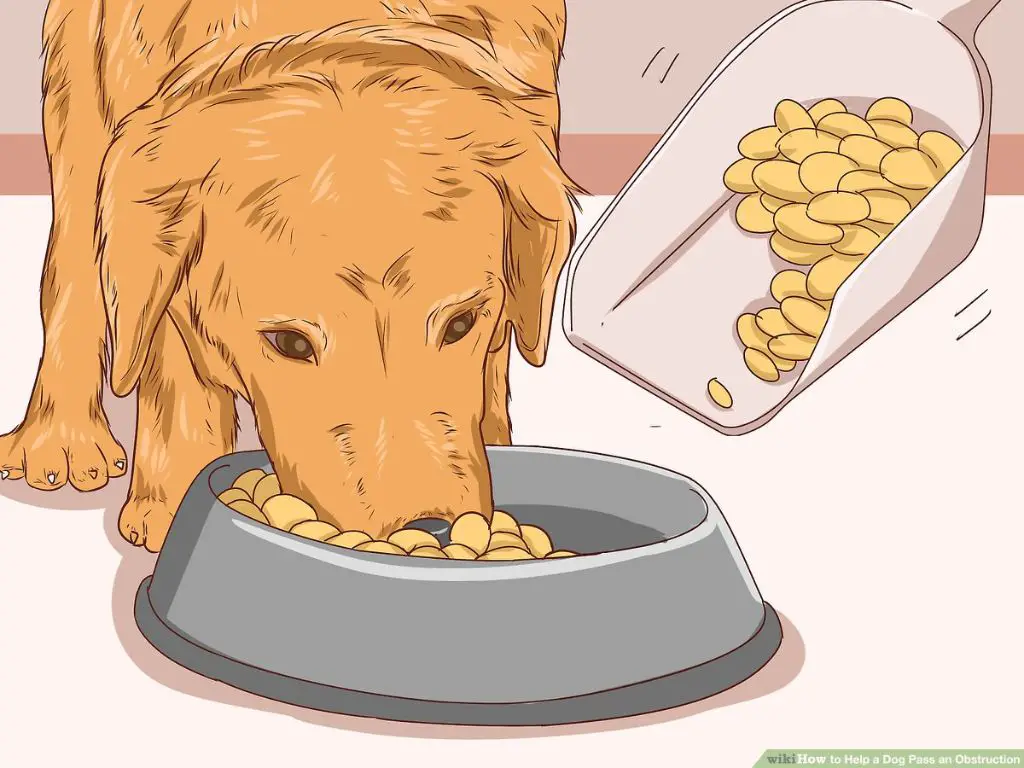What is a blockage in dogs?
A blockage occurs when an obstruction completely or partially blocks the normal passage of food, fluids, air, or waste material through the gastrointestinal tract. Digestive blockages in dogs are a common problem that can be life-threatening.
Common types of blockages dogs can experience include:
- Foreign objects like rocks, toys, clothing, etc.
- Bones
- Excess hair
- Tumors or cancerous growths
- Scar tissue
- Intussusception (when the intestine folds onto itself)
Symptoms of a blockage can include:
- Vomiting
- Loss of appetite
- Weakness and lethargy
- Abdominal pain
- Constipation and lack of bowel movements
- Bloated or distended abdomen
- Straining to defecate without producing anything
Causes of blockages in dogs

Dogs can develop blockages in various parts of their bodies for several reasons. Some of the most common causes of blockages in dogs include:
Ingestion of foreign objects – Dogs have a tendency to eat things they shouldn’t. Swallowed objects like bones, toys, socks, rocks, sticks, and even strings can get lodged in the esophagus, stomach or intestines, causing a blockage.
Inflammation/tumors – Inflammation in the gastrointestinal tract from inflammatory bowel disease or cancerous growths like intestinal polyps or tumors can obstruct digestion. Swelling around the urethra from infection or abnormal tissue growth may also block urine flow.
Bladder stones – Mineral crystals clumping together in the bladder form stones that can block the outflow of urine. This is more common in dogs that don’t drink enough water.
Gastrointestinal issues – Foreign material, tumors, intussusception (telescoping of the intestine), or even severe constipation can all contribute to blocked digestion through the gastrointestinal tract.
Risks of Untreated Blockages
Leaving a blockage untreated in dogs poses many serious health risks that require urgent veterinary attention. Some of the main risks and dangers of an untreated blockage include:
-
Pain – Blockages are very painful and can cause severe abdominal discomfort and distress.
-
Inability to Pass Stool – Blockages prevent the normal passage of food and stool through the intestines.
-
Vomiting – Dogs will frequently vomit as the body tries to expel the obstruction.
-
Bloat – Blockages can lead to gas and fluid building up in the stomach causing dangerous bloat.
-
Infection – Bacteria can multiply around a blockage leading to infection and sepsis.
-
Rupture – An intestinal obstruction left untreated risks a rupture or tear in the intestinal wall.
With prompt veterinary treatment, many dogs recover well from blockages. However, delays can be life-threatening. Recognizing the risks and getting timely care is critical.

Can a blockage clear on its own?
Whether a blockage can pass on its own depends on several factors, including the type, location, and size of the obstruction. Smaller blockages may be able to clear through the gastrointestinal tract without intervention. However, the vast majority of significant blockages require veterinary treatment to resolve.
Small items that a dog swallows, such as pieces of rubber, small bones, or bits of rawhide or fabric, may be able to pass through the digestive system on their own. These blockages can cause vomiting, diarrhea, loss of appetite, and abdominal pain as they move through the intestines. With supportive care at home, it’s possible for smaller obstructions to be eliminated naturally.
However, any sizable object generally will not be able to pass through a dog’s narrow intestinal tract without assistance. Blockages like large bones, balls, rocks, socks, corn cobs, or sticks tend to completely obstruct the intestines and require emergency surgery or endoscopic removal. Similarly, blockages from intussusception, hernias, or tumors require veterinary intervention.
While in some cases a partial blockage may resolve on its own with time, waiting and hoping a major obstruction will clear up without treatment can be very dangerous for a dog. The longer a complete intestinal blockage goes untreated, the higher the risk of severe damage or death. It’s essential to get prompt veterinary care for suspected blockages before a life-threatening emergency develops.
Seeking veterinary care
If you suspect your dog has a blockage, it’s critical to seek veterinary care as soon as possible. Blockages can quickly become life-threatening if left untreated.
Your vet will start by performing a physical exam and taking your dog’s medical history. They may palpate your dog’s abdomen to feel for any obstructions or swelling. Your vet will also check for signs of pain, vomiting, lack of appetite, and lethargy.
Diagnostic tests will likely include:
- Bloodwork to check for signs of infection or electrolyte imbalances
- Urinalysis to assess kidney function
- X-rays or ultrasound to visualize the location and cause of the blockage
Based on your dog’s symptoms and test results, your vet will determine the best course of treatment. This may include:
- IV fluids to prevent dehydration and electrolyte imbalances
- Medications to control nausea, vomiting, and pain
- Surgery to remove the blockage if needed
If your dog has a complete intestinal obstruction or blocked urethra, surgery is often necessary to remove the blockage and prevent a life-threatening rupture. The specific surgical procedure will depend on the location and type of blockage.
It’s important to follow your veterinarian’s recommendations closely after surgery as well. Your dog may need medications, a special diet, and restricted activity during recovery.
Supportive Care at Home
While waiting to see the veterinarian or for a blockage to potentially resolve on its own, there are some supportive care steps you can take at home:

Withholding Food and Water
It is usually recommended to withhold all food and water from a dog with a suspected blockage to allow the gastrointestinal system to rest. Providing food and water can make symptoms worse by stimulating the intestinal tract. Of course, check with your vet on the appropriate care for your dog’s situation.
IV Fluids
Veterinarians may hospitalize dogs with blockages and provide intravenous (IV) fluid therapy to prevent dehydration and restore electrolyte balances. You may be sent home with subcutaneous fluids to administer under your veterinarian’s guidance if your dog is stable enough to avoid hospitalization.
Monitoring Symptoms
While at home, closely monitor your dog for any worsening symptoms like vomiting, diarrhea, lethargy, abdominal pain or distension. Track intake and output. Contact your vet immediately if you have any concerns about your dog’s condition worsening while waiting for treatment.
Preventing Blockages
There are several steps pet owners can take to reduce the risk of their dog developing an intestinal blockage:

Limit Access to Foreign Objects
Dogs are naturally curious and may swallow random items they find interesting or tasty. Things like socks, toys, rocks, and sticks can easily get lodged in the digestive tract. Dog owners should regularly scan the home and yard for potential hazards and restrict access when possible. Crates, baby gates, and closed doors can help keep dogs away from dangerous areas.
Proper Diet
Feeding a high quality dog food designed for your pet’s size, age, and activity level can promote good digestive health. Avoid overfeeding and give treats sparingly. Bones, rawhides, and dental chews can also pose a choking risk and should be supervised.
Dental Care
Regular dental cleanings and tooth brushing can reduce the buildup of plaque and calculus that may tempt dogs to swallow loose pieces that could cause an obstruction. Professional dental care may be advised for some dogs.
Recognizing an Emergency
If your dog is exhibiting signs of a blockage, it’s important to recognize when the situation has become a life-threatening emergency requiring immediate veterinary care. There are a few key signs that signal an emergency situation:
Difficulty Breathing
If your dog is struggling to breathe normally or seems to be breathing rapidly or with effort, this indicates the blockage may be obstructing the airways or putting pressure on the lungs and diaphragm. Difficulty breathing is an emergency.
Non-Productive Vomiting
Dogs may vomit frequently with a blockage as their body tries to expel the obstruction. However, if your dog is vomiting repeatedly with no results, this is a sign the blockage is not moving or resolving on its own. Non-productive vomiting is a sign of a complete obstruction.
Lethargy
A blocked intestine can cause toxins to build up in the bloodstream, causing lethargy or even collapse. If your dog seems extremely tired, weak, or unable to stand, this indicates a dangerous level of toxicity.
Abdominal Distension
As the intestines become obstructed, the abdomen often becomes bloated or distended. If you notice a swollen or hard belly, it means your dog is developing a dangerous backup of gas and fluids in the intestines that requires emergency surgery.
If your dog shows any of these emergency signs, do not wait to see if the blockage resolves on its own. Call your vet or emergency animal hospital immediately, as prompt surgery is required to save your dog’s life.
Prognosis:
The prognosis for dogs with blockages is generally good if prompt veterinary treatment is received. However, delays in treatment can allow the obstruction to worsen, increasing the risks of complications such as rupture or sepsis. The earlier the blockage is diagnosed and addressed, the better the outcome typically is.
If the intestine ruptures due to the blockage, the prognosis becomes more guarded. Intestinal rupture leads to peritonitis, which can be life-threatening without swift surgical intervention. Therefore, it is crucial not to wait and see if a suspected blockage will resolve on its own.
The underlying cause of the obstruction also affects prognosis. Blockages from foreign objects that require surgery to remove have a good prognosis if treated early. However, obstructions due to intestinal cancer may have a more guarded outlook depending on the type and stage of cancer.
Overall, intestinal obstructions often carry a positive prognosis when appropriately diagnosed and managed by a veterinarian. Still, it is essential not to delay seeking care, as waiting can allow the condition to progress and complications to develop that severely impact the eventual outcome.
When to seek vet follow-up
Even after successful treatment for a blockage, it’s important to follow up with your vet. This allows them to check for any lingering issues and ensure your dog is recovering well.
You should schedule a recheck appointment with your vet:
- After surgical treatment – To monitor healing and watch for any post-op complications like infection.
- If symptoms return – Blockages can recur in some cases, so contact your vet if you notice vomiting, appetite loss, or other concerning signs.
- For ongoing management if a chronic issue – Some dogs are prone to blockages and may need long-term care to prevent recurrences. Work with your vet on prevention and monitoring.
Don’t hesitate to call your veterinarian if you have any concerns after treating a blockage. They can assess your dog and determine if further treatment is needed for full recovery.